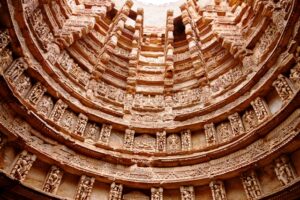
The Rani-Ki-Vav is a stepwell located at Patan, Gujarat. Stepwells are a unique form of water resource and storage system in India, as they are wells in which the water may be reached by descending a series of steps. The Rani-Ki-Vav is said to have been built during the 11 th century A.D. in memory of the Solanki king, Bhimdev I. As its construction was commissioned by his widowed wife, Queen Udayamati, it was aptly named as the Rani-Ki-Vav (“The Queen’s Stepwell).
The ornate and beautifully decorated stepwell was built in the Maru-Gurjara architectural style, and measures 64 m in length, 20 m in width and 28 m in depth. The stepwell is divided into seven levels of stairs, the deepest of which is the fourth level. This level leads into a rectangular tank. As with other stepwells, the Rani-Ki-Vav was built to provide water, shade from the scorching Indian heat, and as a place for the community to gather together.
In addition to the practical functions of the Rani-Ki-Vav, it was also an aesthetic masterpiece. The stairs are covered with sculptural panels depicting religious, secular and mythological imagery. The major sculptures number at over 500, while the minor ones number at over a thousand. These sculptures include images such as that of the ten incarnations of Vishnu, Shiva, Brahma, Ganesh, Lakshmi, apsaras (heavenly dancers), nangkanyas (serpent women) and yoginis (female yoga practitioners). Interestingly, it has been observed that the sculptures of the apsaras showcase the solah-shringar, which is a term used to describe the 16 different styles of make-up used to make a woman look more attractive.
Outstanding Universal Value
Rani-ki-Vav is an exceptional example of a distinctive form of subterranean water architecture of the Indian subcontinent, the stepwell. Initially built as a memorial in the 11th century CE, the stepwell was constructed as a religious as well as functional structure and designed as an inverted temple highlighting the sanctity of water. Rani-ki-Vav is a single-component, water management system divided into seven levels of stairs and sculptural panels of high artistic and aesthetic quality. It is oriented in an east-west direction and combines all of the principle components of a stepwell, including a stepped corridor beginning at ground level, a series of four pavilions with an increasing amount of storeys towards the west, the tank, and the well in tunnel shaft form. More than five hundred principle sculptures and over a thousand minor ones combine religious, mythological and secular imagery, often referencing literary works.
Rani-ki-Vav impresses not only with its architectural structure and technological achievements in water sourcing and structural stability, but also in particular with its sculptural decoration, of true artistic mastery. The figurative motifs and sculptures, and the proportion of filled and empty spaces, provide the stepwell’s interior with its unique aesthetic character. The setting enhances these attributes in the way in which the well descends suddenly from a plain plateau, which strengthens the perception of this space.
Criterion (i): Rani-ki-Vav (The Queen’s Stepwell) at Patan, illustrates an example of the artistic and technological height of stepwell tradition. It has been decorated with religious, mythological and at times secular sculptures and reliefs, illustrating a true mastery of craftsmanship and figurative expression. The stepwell represents an architectural monument of human creative genius in its variety of motifs and its elegance of proportions, which frame an intriguing space, both functional and aesthetic.
Criterion (iv): Rani-ki-Vav is an outstanding example of a subterranean stepwell construction and represents a prime example of an architectural type of water resource and storage system which is widely distributed across the Indian subcontinent. It illustrates the technological, architectural and artistic mastery achieved at a stage of human development when water was predominantly resourced from ground water streams and reservoirs through access of communal wells. In the case of Rani-ki-Vav, the functional aspects of this architectural typology were combined with a temple-like structure celebrating the sanctity of water as a venerated natural element and the depiction of highest-quality Brahmanic deities.
Source:
http://whc.unesco.org/en/list/922
https://www.sahapedia.org/the-ran-ki-vav-stepwell-patan-gujarat


